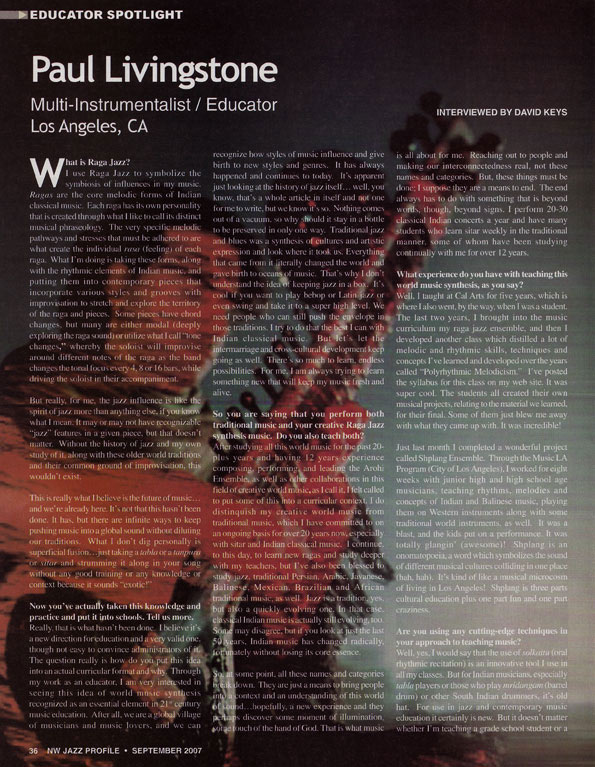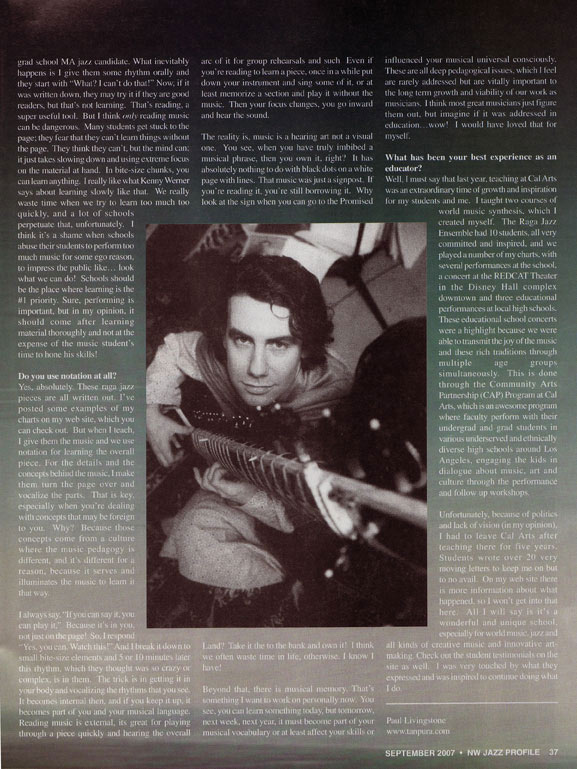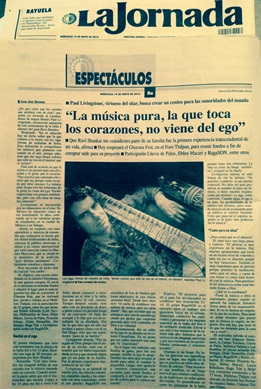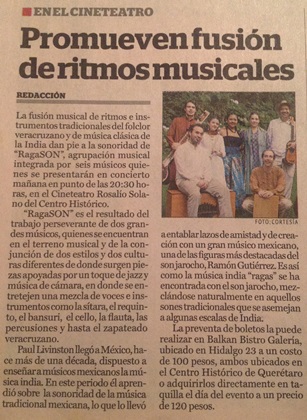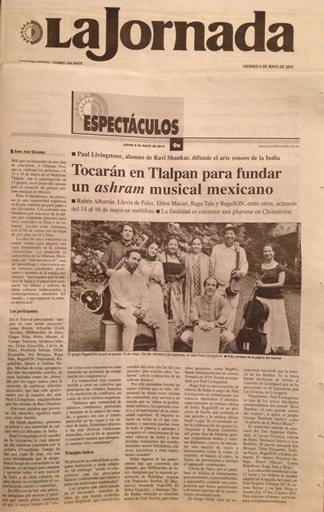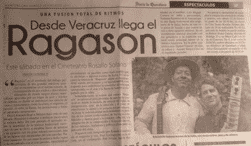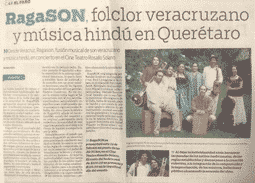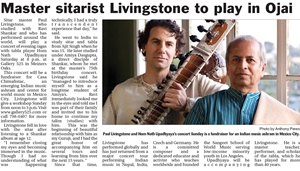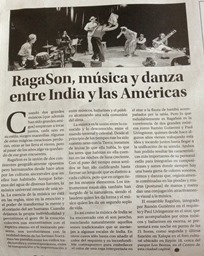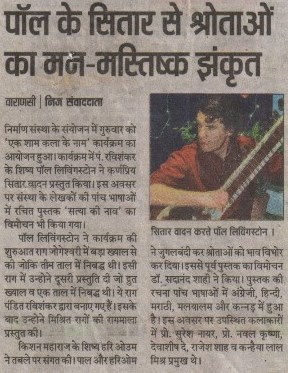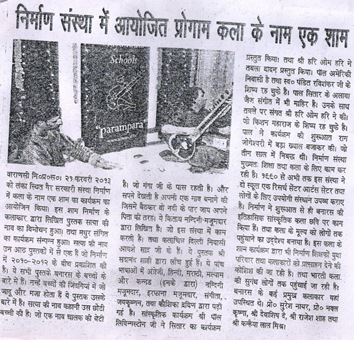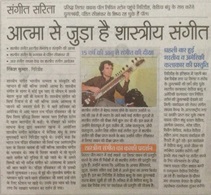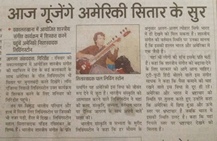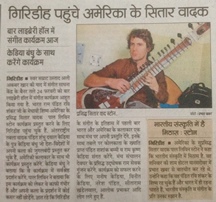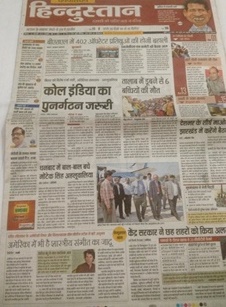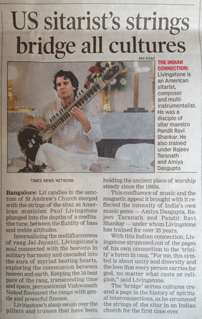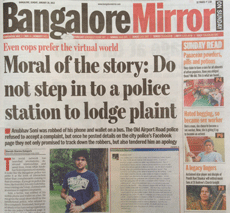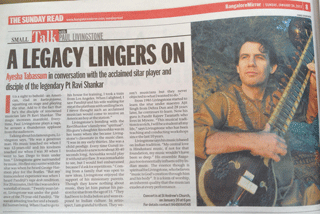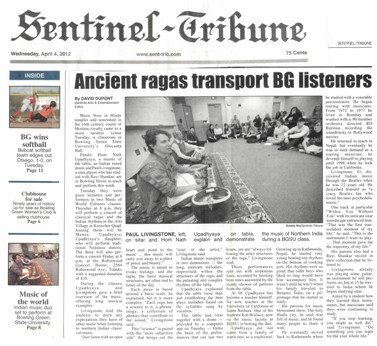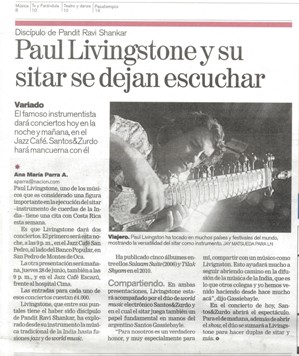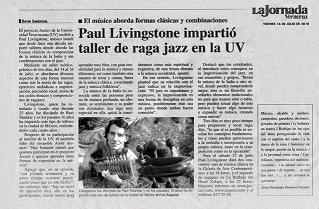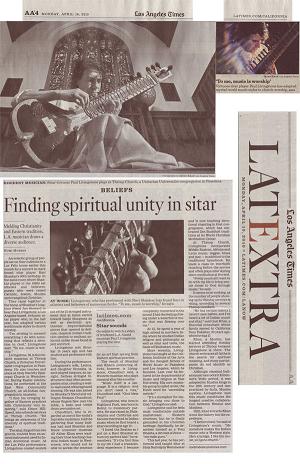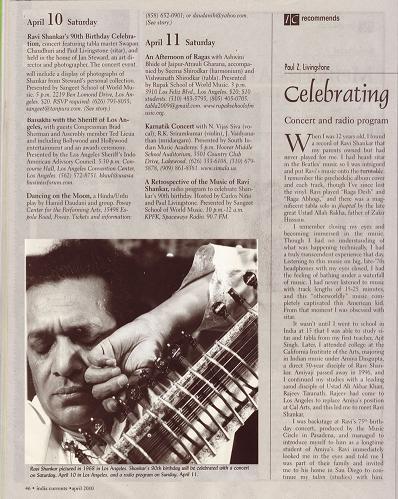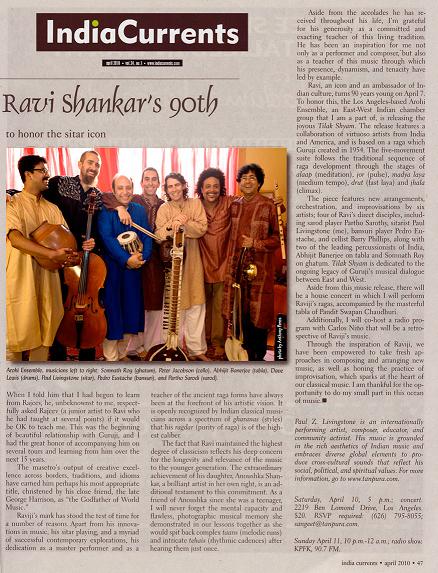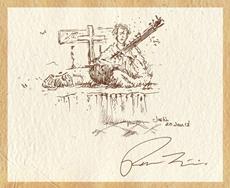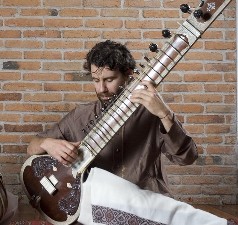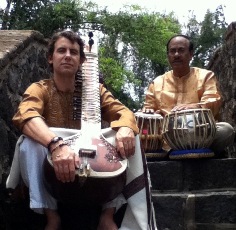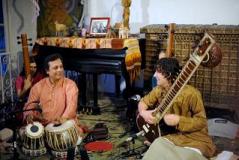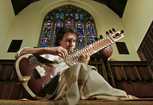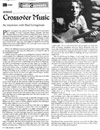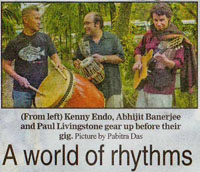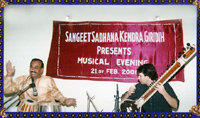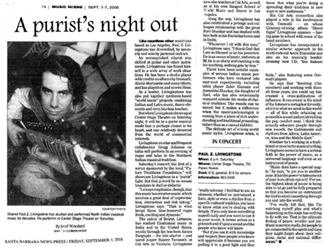What is Raga Jazz?
I use Raga Jazz to symbolize the symbiosis of influences
in my music. Ragas are the core melodic forms of Indian
classical music. Each raga has it's own personality that
is created through what I like to call it's distinct musical
phraseology. The very specific melodic pathways &
stresses that must be adhered to are what creates the
individual rasa (feeling) of each raga. What I'm doing
is taking these forms, along with the rhythmic elements
of Indian music, and putting them into contemporary pieces
that incorporate various styles & grooves with improvisation
to stretch and explore the territory of the raga &
pieces. Some pieces have chord changes, but many are either
modal (deeply exploring the raga sound) or utilize what
I call tone changes, whereby the soloist will improvise
around different notes of the raga as the band changes
the tonal focus every 4, 8 or 16 bars, while driving the
soloist in their accompaniment.
But really for me the jazz influence is like the spirit
of jazz more than anything else if you know what I mean…
it may or may not have recognizable 'jazz' features in
a given piece but that doesn't matter. Without the history
of jazz and my own study of it, along with these older
world traditions and their common ground of improvisation,
this wouldn't exist.
This is really what I believe is the future of music…
and we're already here. It's not that this hasn't been
done, it has, but there are infinite ways to keep pushing
music into a global sound without diluting our traditions.
What I don't dig personally is superficial fusion, just
taking a tabla or a tanpura or sitar and strumming it
along in your song without any good training or any knowledge
or context because it sounds 'exotic'!
Now you've actually taken this knowledge and
practice and putting it into schools?
Yes, and really that is what hasn't been done. I believe
it's a new direction for education and a very valid one,
though not easy to convince administrators of it. The
question really is how do you put this idea into an actual
curricular format and why? Through my work as an educator,
I am very interested in seeing this idea of world music
synthesis recognized as an essential element in 21st century
music education. After all, we are a global village of
musicians and music lovers and we can recognize how styles
of music influence and give birth into new styles &
genres. It has always happened and continues to today.
It's apparent just looking at the history of jazz itself…
well, you know, that's a whole article in itself and not
one for me to write, but we know it's so. Nothing comes
out of a vacuum, so why should it stay in a bottle to
be preserved in only one way. Traditional jazz & blues
was a synthesis of cultures and artistic expression and
look where it took us. Everything that came from it literally
changed the world and gave birth to oceans of music. That's
why I don't understand the idea of keeping jazz in a box.
It's cool if you want to play bebop or Latin jazz or even
swing and take it to a super high level. We need people
who can still push the envelope in those traditions. I
try to do that the best I can with Indian classical music.
But let's let the intermarriage and cross-cultural development
keep going as well. There's so much to learn, endless
possibilities. For me, I am always trying to learn something
new that will keep my music fresh and alive.
So you are saying that you perform both traditional
music & your creative Raga Jazz synthesis music. Do
you also teach both?
After studying all this world music for the past 20+
years and having 12 years experience composing, performing,
leading the Arohi Ensemble, as well as other collaborations
in this field of creative world music, as I call it, I
felt called to put some of this into a curricular context.
I do distinguish my creative world music from traditional
music, which I have committed to on an ongoing basis for
over 20 years now, especially with sitar & Indian
classical music. I continue, to this day, to learn new
ragas and study deeper with my teachers, but I've also
been blessed to study jazz, traditional Persian, Arabic,
Javanese, Balinese, Mexican, Brazilian & African traditional
music as well. Jazz is a tradition, yes, but also a quickly
evolving one. In that case, classical Indian music is
actually still evolving too. Some may disagree, but if
you look at just the last 50 years, Indian music has changed
radically, fortunately without losing its core essence.
So, at some point, all these names & categories break
down. They are just a means to bring people into a context
and an understanding of this world of sound. Hopefully,
a new experience and they perhaps discover some moment
of illumination, some touch of the hand of God. That is
what music is all about for me. Reaching out to people
and making our interconnectedness real, not these names
and categories. But, these things must be done, I suppose
they are a means to end. The end has always to do with
something that is beyond words though, beyond signs.
I perform 20-30 classical Indian concerts a year and
have many students who learn sitar weekly in the traditional
manner, some of whom have been studying continually with
me for over 12 years.
What experience do you have with teaching this world
music synthesis… as you say.
Well, I taught at Cal Arts for 5 years, which is where
I also went, by the way, when I was a student. The last
2 years, I brought into the music curriculum my Raga jazz
Ensemble and then another class I developed which distilled
a lot of melodic & rhythmic skills, techniques and
concepts I've learned and developed over the years called,
'Polyrhythmic Melodicism'. I've posted the syllabus for
this class on my website. It was super cool. The students
all created their own musical projects for their final,
relating to the material we learned. Some of them just
blew me away with what they came up with. It was incredible!
Just last month I completed a wonderful project called
'Shplang Ensemble'. Through the Music LA Program (City
of Los Angeles) I worked for 8 weeks with Jr. High &
High school age musicians, teaching rhythms, melodies
and concepts of Indian and Balinese music, playing them
on western instruments along with some traditional world
instruments as well. It was a blast, and the kids put
on a performance. It was totally glangin' (awesome)! Shplang
is an onomatopoeia, a word which symbolizes the sound
of different musical cultures colliding in one place,
hah hah. It's kind of like a musical microcosm of living
in Los Angeles! Shplang is three parts cultural education
+ one part fun and one part craziness.
Are you using any cutting-edge techniques in
your approach to teaching music?
Well yes, I would say that the use of solkattu (oral
rhythmic recitation) is an innovative tool I use in all
my classes. But for Indian musicians especially, tabla
players or those who play mridangam (barrel drum) or other
South Indian drummers, it's old hat. For use in jazz and
contemporary music education it certainly is new. But
it doesn't matter whether I'm teaching a grade school
student or a grad school MA jazz candidate. What inevitably
happens is I give them some rhythm orally and they start
with "What? I cant do that!" Now, if it was
written down they may try it if they are good readers…
but that's not learning. That's reading, a super useful
tool. But I think only reading music can be dangerous.
Many students get stuck to the page; they fear that they
can't learn things without the page. They think they can't
but the mind can, it's just takes slowing down and using
extreme focus on the material at hand. In bite size chunks
you can learn anything. I really like what Kenny Werner
says about learning slowly like that. We really waste
time when we try to learn too much too quickly, and a
lot of schools perpetuate that, unfortunately. I think
it's a shame when schools abuse their students to perform
too much music for some ego reason, to impress the public
like… look what we can do! Schools should be the place
where learning is the #1 priority and, sure, performing
is important, but in my opinion should come after learning
material thoroughly and not at the expense of the music
student's time to hone their skills!
Do you use notation at all?
Yes, absolutely. These ragajazz pieces are all written
out. I've posted some examples of my charts on my website,
which you can check out. But when I teach, I give them
the music and we use notation for learning the overall
piece, but for the details and the concepts behind the
music, I make them turn the page over and vocalize the
parts. That is key, especially when you're dealing with
concepts that may be foreign to you. Why? Because those
concepts come from a culture where the music pedagogy
is different and it's different for a reason, because
it serves and illuminates the music to learn it that way.
I always say, "if you can say it you can play it".
Because it's in you, not just on the page! So I respond
"yes you can…watch this" and I break it down
to small bite size elements and 5 or 10 minutes later
this rhythm, which they thought was so crazy or complex,
is in them. The trick is in getting it in your body and
vocalizing the rhythms that you see. It becomes internal
then and if you keep it up, it becomes part of you and
your musical language. Reading music is external, its
great for playing through a piece quickly & hearing
the overall arc of it, for group rehearsals etc. Even
if you're reading to learn a piece, once in a while put
down your instrument and sing some of it, or at least
memorize a section and play it without the music. Then
your focus changes, you go inward and hear the sound.
The reality is, music is a hearing art not a visual one.
You see, when you have truly imbibed a musical phrase,
then you own it, right? It has absolutely nothing to do
with black dots on a white page with lines. That music
was just a signpost. If you're reading it, you're still
borrowing it. Why look at the sign when you can go to
the Promised Land? Take it the to the bank and own it!
I think we often waste time in life otherwise. I know
I have!
Beyond that, there is musical memory. That's something
I want to work on personally now. You see, you can learn
something today, but tomorrow, next week, next year, has
it become part of your musical vocabulary or has it at
least affected your skills or influenced your musical
universal consciously. These are all deep pedagogical
issues, which I feel are rarely addressed but are vitally
important to the long term growth and viability of our
work as musicians. I think most great musicians just figure
them out, but imagine if it was addressed in education…wow!
I would have loved that for myself.
What has been your best experience as an educator?
Well, I must say that last year, teaching at Cal Arts
was an extraordinary time of growth & inspiration
for me and my students. I taught two courses of world
music synthesis, which I created myself. The 'Raga Jazz
Ensemble' had 10 students, all very committed and inspired,
and we played a number of my charts, with several performances
at the school, a concert at the REDCAT Theater in the
Disney Hall complex downtown & 3 educational performances
at local High Schools. These educational school concerts
were a highlight because we were able to transmit the
joy of the music and these rich traditions through multiple
age groups simultaneously. This is done through the Community
Arts Partnership (CAP) Program at Cal Arts, which is an
awesome program where faculty perform with their undergrad
& grad students in various underserved & ethnically
diverse High Schools around Los Angeles, engaging the
kids in dialogue about music, art & culture through
the performance and follow up workshops.
I had to leave Cal Arts after teaching
there for 5 years but all I will say is it's a wonderful and
unique school, especially for world music, jazz &
all kinds of creative music and innovative art-making.
Check out the student testimonials on the site as well.
I was very touched by what they expressed and inspired
to continue doing what I do.
Paul Livingstone
